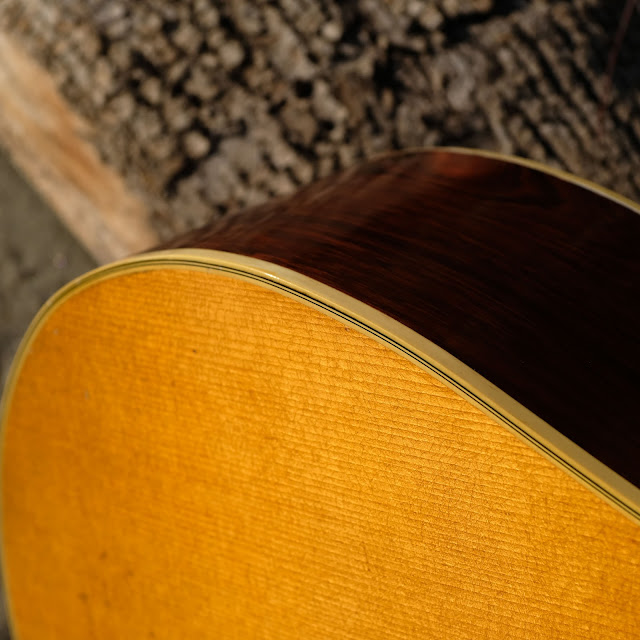1940s Vega Profundo Brazilian Rosewood Dreadnought Guitar
Update 2/28/2018: This guitar is back in for consignment and after a year-plus of living elsewhere, all I needed to do was restring it and it was ready for the wall. The previous owner decided to downsize the size of his guitars. I've taken new photos and recorded a video clip and so have updated the post with them.
As a huge fan of Vega instruments, I've seen Profundos kicking around on the net, but none of them with Brazilian rosewood for the back and sides like this one has. Also, all of the same-period Vega guitars I've had the pleasure to work on have had ladder bracing or a variant of it while this one has had its original bracing replaced with professionally-installed, lightly-done, scalloped x-bracing. It's, in effect, braced very much like a 30s Martin dreadnought.
As a huge fan of Vega instruments, I've seen Profundos kicking around on the net, but none of them with Brazilian rosewood for the back and sides like this one has. Also, all of the same-period Vega guitars I've had the pleasure to work on have had ladder bracing or a variant of it while this one has had its original bracing replaced with professionally-installed, lightly-done, scalloped x-bracing. It's, in effect, braced very much like a 30s Martin dreadnought.
So, what do you think it sounds like? Yes -- like a superb D-28 crossed with a great J-45 -- excellent punch and volume, a huge and robust bottom-end, and lots of clarity and fundamentals. It's a wonderful "bluegrass" guitar but, due to its slightly-different overall build, also stands-in beautifully as a chord-banging thunder-box for a singer as well.
Unlike a Martin it has a shorter 25" scale, mild-medium rounded-V neck shape, and 1 5/8" (well, really just a hair over that) nut width, which gives it a neck feel that's something of a hybrid between period Epiphone necks and period Gibson necks. The waist also sits a little lower on the body and the shoulders are slightly rounder which means it sits more like a Gibson in the lap, though the waist itself is wider in feel like a Martin. It's an interesting mix of features that all add-up to a superlative dreadnought. It's simply fun to play.
There's a 39629 serial number at the headstock but, unfortunately, the guitar serial numbers don't mean much to us these days. Suffice to say, the guitar dates from the late 30s into the mid 40s at the latest.
The body is a full 16 1/8" on the lower bout -- chasing after the Gibson vibe. The body depth is 5" at the endblock.
Now, aside from the bracing, there are other alterations to the instrument, too. The finish has had one coat of overspray overall (not sure about the headstock and top -- they may just be touched-up) and perhaps a little color touch-up on the back of the neck. It's also had a Martin-style sticky-backed pickguard installed (the original would've been a raised, archtop-style guard) and Grover tuners added at the headstock (to replace old openback Klusons).
Now, aside from the bracing, there are other alterations to the instrument, too. The finish has had one coat of overspray overall (not sure about the headstock and top -- they may just be touched-up) and perhaps a little color touch-up on the back of the neck. It's also had a Martin-style sticky-backed pickguard installed (the original would've been a raised, archtop-style guard) and Grover tuners added at the headstock (to replace old openback Klusons).
The bridge, too, is a replacement but looks very much like the original Vega types save for a drop-in saddle slot.
The frets are newer, too, and medium in size. My only work on this was to give it a fret level/dress, extra compensation and adjustment at the saddle, a setup, and new ebony pins at the bridge and endpin. The neck adds ~1mm relief overall when tuned to pitch with 12s, but remains stable and the action is dead-on at 1/16" DGBE and 3/32" EA at the 12th fret.
Currently I have a set of 54w, 40w, 30w, 22w, 16, 12 strings on it which are just a touch lighter than regular 54w-12s in the middle so as to take a little extra tension off of the lightly-braced top.
Currently I have a set of 54w, 40w, 30w, 22w, 16, 12 strings on it which are just a touch lighter than regular 54w-12s in the middle so as to take a little extra tension off of the lightly-braced top.
The nut is bone and original, I think. The yellow stripes are actually raised off of the peghead -- a neat effect.
I love the quirky Vega inlay. The board is radiused and ebony and the celluloid binding is original all-around.
Note the filled hole next to the fretboard extension -- that's where an elevated pickguard used to be installed.
Also, as far as previous work goes -- I'm fairly certain that this had a neck reset in the past, too.
The soundhole is smaller than other makes but that helps to emphasize the bass rumble. I love the simple rosette, too.
There are no cracks on the guitar except for two, small, repaired hairlines at the furthest extremities of the lower bout on the back.
The pins are ebony all-around and there's plenty of saddle height for action adjustments. Note the very Martin-style string load with the pins close to the saddle -- that increases back-angle on it and affords some insane punch, tonally.
The real treat is the excruciatingly-pretty Brazilian rosewood used in the back and sides. I mean -- oh, my!
This has a 9-piece backstrip.
A vintage, beat-up-but-functional, arched-lid, blue-lined hard case comes with it.
























Comments